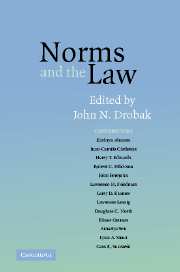Book contents
- Frontmatter
- Contents
- List of Contributors
- Acknowledgments
- Introduction
- PART ONE RATIONALITY AND NORMS
- PART TWO NORMS OF THE COMMONS
- PART THREE JUDICIAL NORMS
- 7 Judging the Judges: Some Remarks on the Way Judges Think and the Way Judges Act
- 8 Judicial Independence in a Democracy: Institutionalizing Judicial Restraint
- 9 Black Judges and Ascriptive Group Identification
- 10 Judicial Norms: A Judge's Perspective
- PART FOUR THE INFLUENCE OF LAW ON NORMS
- References
- Index
10 - Judicial Norms: A Judge's Perspective
Published online by Cambridge University Press: 05 June 2012
- Frontmatter
- Contents
- List of Contributors
- Acknowledgments
- Introduction
- PART ONE RATIONALITY AND NORMS
- PART TWO NORMS OF THE COMMONS
- PART THREE JUDICIAL NORMS
- 7 Judging the Judges: Some Remarks on the Way Judges Think and the Way Judges Act
- 8 Judicial Independence in a Democracy: Institutionalizing Judicial Restraint
- 9 Black Judges and Ascriptive Group Identification
- 10 Judicial Norms: A Judge's Perspective
- PART FOUR THE INFLUENCE OF LAW ON NORMS
- References
- Index
Summary
In reflecting on “judicial norms,” I will offer some views on judicial restraint, independence, impartiality, autonomy, and interdependence. I will also stress the importance of collegiality in judicial decisionmaking and highlight what I see to be the advantages of a diverse judiciary.
In amplifying my views, I will comment on three essays: John Ferejohn and Larry Kramer, Judicial Independence in a Democracy: Institutionalizing Judicial Restraint; Lawrence Friedman, Judging the Judges: Some Remarks on the Way Judges Think and the Way Judges Act; and Kathryn Abrams, Black Judges and Ascriptive Group Identification. This will allow me to lend a judge's perspective to the analyses offered by these preeminent legal scholars.
SOME COMMENTS ON PROFESSOR FEREJOHN'S AND DEAN KRAMER'S JUDICIAL INDEPENDENCE IN A DEMOCRACY: INSTITUTIONALIZING JUDICIAL RESTRAINT
The chapter authored by Professor Ferejohn and Dean Kramer is a long and scholarly piece which attempts to rationalize institutional doctrines of judicial restraint employed by the federal courts in the United States. I want to begin by saying that, in my view, Professor Ferejohn and Dean Kramer have got it basically right in their essay. The Constitution makes judges dependent on the political branches in a variety of ways. Individual judges are not terribly vulnerable to control from the political branches, but the judiciary as a whole is somewhat vulnerable. As a result of this arrangement, the judiciary has developed a set of self-imposed institutional doctrines of restraint. By regulating itself, the judiciary protects its ability to have its judgments effectuated.
- Type
- Chapter
- Information
- Norms and the Law , pp. 230 - 244Publisher: Cambridge University PressPrint publication year: 2006
- 1
- Cited by

